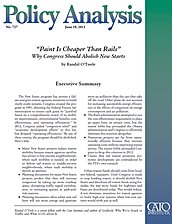- Many New Starts projects reduce transit mobility because transit agencies sacrifice bus service to low-income neighborhoods, where such mobility is needed, in order to deliver rail transit to middle-income neighborhoods, where such mobility is merely an amenity.
- Planning documents for many New Starts projects predict that they will increase congestion by taking up more roadway space, disrupting traffic signal coordination, or increasing queues at park-andride stations.
- Planning documents often admit new rail lines will use more energy and generate more air pollution than the cars they take off the road. Other plans do not account for increasing automobile energy efficiencies or the effects of congestion on energy consumption and air pollution.
- The Bush administration attempted to use the cost-effectiveness requirement to place an upper limit on project costs, but the transit lobby has persuaded the Obama administration and Congress to effectively eliminate this criterion altogether.
- Numerous projects are far from operationally efficient because they increase operating costs without improving transit service. The transit lobby persuaded Congress to drop this criterion in 2012.
- Claims that rail transit promotes economic development are contradicted by the FTA’s own research.
Urban transit funds should come from local, not federal, taxpayers. Until Congress is ready to stop funding transit, it should abolish New Starts and distribute all transit funds using formulas, the way most funds for highways and buses are distributed today. This would reduce, if not eliminate, incentives for transit agencies to build high-cost systems when low-cost systems would work just as well.

